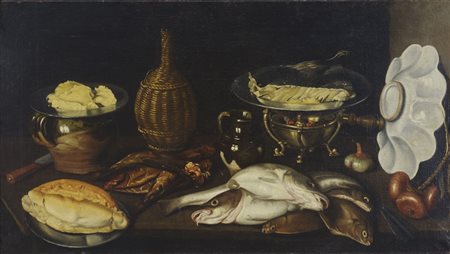 Florence Number Nine - Via del Poggio Imperiale 9, 50125 Firenze
Florence Number Nine - Via del Poggio Imperiale 9, 50125 Firenze
Asta di Dipinti, Sculture e Disegni antichi Sessione Unica
Monday 14 October 2013 hours 15:00 (UTC +01:00)
Paolo Antonio Barbieri (Cento 1603-1649) Natura morta di pesci di mare Olio...
Paolo Antonio Barbieri
(Cento 1603-1649) Natura morta di pesci di mare
Olio su tela, in bella cornice bolognese coeva intagliata e dorata
cm. 59,5x105
The painting has been identified, for documentary and stylistic reasons, as an autographed work by the brother of Guercino, Paoloantonio Barbieri. This is supported by a verbal opinion from Sir Denis Mahon and confirmed by Prof. Andrea Emiliani. The first art historian to suggest the painter of this still life was Francesca Baldassari, who underlined that the painting was from the Emilia region of Italy. An investigation into the famous "Libro dei Conti" by Guercino, which was known to have been kept by his brother Paoloantonio, which lists all the works that left the workshop, clearly states on page 129: " Dall'Ill.mo Sig: Enrico Sampieri, ho ricevuto doppie n. X per il Quadro di Pesci di Mare, che fanno in tuto scudi 37e mezo - Li 9 febraio 1646." That the specification of a painting with "saltwater fish" from over forty still lifes listed in the book appears only here. On examining the painting, we see a classical arrangement of objects placed in perspective on a table. In the foreground, there are three red onions (very similar to those in the work painted together with dell'Ortolana, once in Vignola’s private collection) and a pile of saltwater fish, sole and red mullet. Characteristic bread from Ferrara is depicted on the left side of the scene on a pewter plate wrapped in the same manner as bread shops in Ferrara still do today. The middle ground presents a fine white “crespina” (a type of dish) from Faenza, an elegant metal brazier on which glowing embers warm a slice of turbot, a glazed carafe from Faenza, a straw-wrapped flask and a two-handled vessel (again from Faenza) stuffed with pioppini mushrooms. A knife with clearly visible initials on the blade, a type of ideogram, is situated at the viewer’s far left, that consists of two interwoven and overlapping letters: P and B; Paoloantonio Barbieri.



